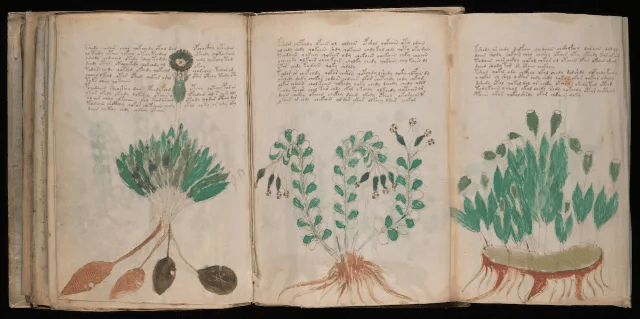
The Voynich Manuscript – A Book No One Can Read
Discovery and Description
In 1912, rare book dealer Wilfrid Voynich acquired a strange manuscript from a Jesuit college near Rome. It was immediately clear this wasn’t an ordinary book.
- 240 vellum pages, estimated to have been written around 1404–1438, using quill and iron gall ink
- Filled with detailed illustrations of unknown plants, naked women bathing in strange tubs, zodiac signs, and elaborate astronomical diagrams
- Every single page is written in an entirely unknown script — called Voynichese
The manuscript now resides at Yale University’s Beinecke Rare Book & Manuscript Library, catalogued as MS 408.
What’s Inside the Manuscript?
Scholars typically divide the book into sections based on illustrations:
🌿 Herbal section
Features bizarre plants — many with parts from real flora, others seemingly invented
🛁 Balneological section
Shows nude women in baths connected by tubes — as if in some medieval plumbing system
♈ Astrological section
Includes star charts, zodiac wheels, and symbols resembling cosmic calendars
🍽 Pharmaceutical section
Shows labeled jars, roots, and mortar/pestle tools — suggesting alchemical or medicinal knowledge
🔤 Text-only section
Pages of continuous writing with no known breaks, punctuation, or deciphered vocabulary
What Language Is It Written In?
No one knows.
- It’s not Latin, Greek, Arabic, or any known language
- It doesn’t match any modern or ancient alphabet
- It shows linguistic patterns (like repeating prefixes/suffixes) that suggest a real language — but it doesn’t match any human one
Experts using AI, cryptography, and linguistics have failed to crack it.
Some have proposed it’s:
- A cipher — encoded text hiding another language
- A constructed language (like Elvish or Klingon)
- A nonsense hoax
- A language written phonetically using a custom script
Theories About Its Origin
1. Hoax theory
Some scholars believe it’s a 15th-century elaborate prank, made to sell for profit to nobles seeking "ancient wisdom."
Yet, the amount of work (over 200 pages of consistent grammar and illustrations) makes this unlikely.
2. Lost language or cipher
It may be a real language now extinct — or an early attempt at scientific encryption. But no "key" has ever surfaced.
3. Alchemical or medical treatise
The themes suggest medieval science, likely related to healing, fertility, or astronomy — possibly written for a secret society or woman’s health guild.
4. Alien or channelled knowledge
A fringe theory posits the author "received" the information through visions or contact. Some point to the unnatural plants and anatomical oddities as signs of this.
Modern Investigations
- Carbon dating confirms the parchment is from 1404–1438
- The ink is consistent with that time period
- No corrections or alterations in the script — as if the author knew the “language” perfectly
In 2020, researchers used AI to match some patterns to Hebrew, suggesting the book might be a code using an abjad (a script omitting vowels), but this remains unconfirmed and controversial.
A Book With No Author, No Reader, and No Meaning… Yet
**Who wrote it? Why did they create it?
Is it a code waiting to be broken…
or the most elaborate riddle in literary history?**
The Voynich Manuscript is one of the only books on Earth that cannot be read, no matter how advanced our tools become. It sits in a glass case — 600 years old, taunting us still.